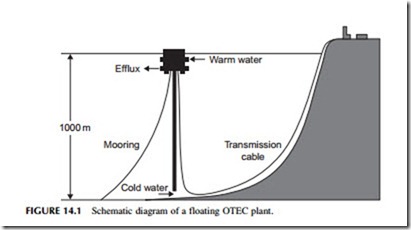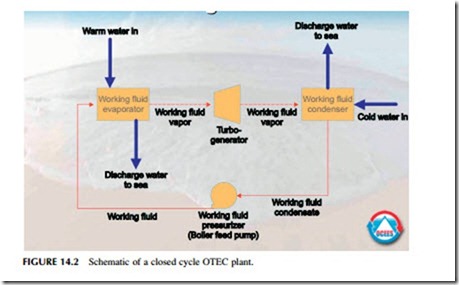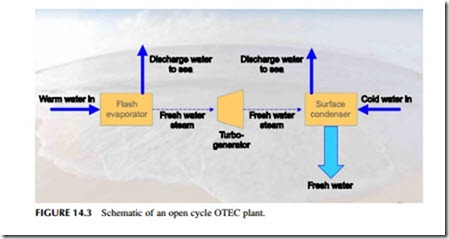OCEAN THERMAL ENERGY CONVERSION
OTEC takes advantage of the temperature difference between the sea surface and the deep sea or ocean to drive a thermodynamic heat engine that can generate electricity. The best regions for OTEC are usually found within 20o of the equator. Here the surface water temperature can rise to between 25 oC and 33 oC. The hot surface water does not mix with deeper water, so there is a significant temperature gradient between the surface and lower strata. The latter can remain at a temperature of only 9 oC at a depth of 500 m and below 5 oC at a depth of 1 km.
The amount of energy absorbed by tropical oceans is enormous. Estimates from the U.S. National Renewable Energy Laboratory suggest that across the 60 million km2 of tropical ocean an amount of energy equivalent to as much as 250 billion barrels of oil/day is absorbed. If only a small fraction of this could be converted into electrical power it would provide a massive resource.
An OTEC plant requires a temperature gradient of 20 oC to be able to operate effectively. This means that a surface temperature of 25 oC will normally be necessary and access to colder waters at 5 oC or less. To access this cold water, an OTEC plant must be able to reach at least to 500 m below the sea surface, and for efficient operation it will normally need to pump water from as much as 1000 m down.
A land-based plant, even with deep water close to the shore, is likely to require a pipe of at least 2 km in length to reach sufficiently cold water. The alternative is to build the OTEC plant on a floating platform that is tethered offshore with the cold water pipe hanging from the support, and then carrying the power to the shore via a seabed cable (Figure 14.1). Even with this arrangement, the platform may have to support a pipe of 1 km in length. More generally, if OTEC is to provide anything more than very small amounts of power, plants will need to be able to operate in the open sea where they will have to support a pipe capable of pumping water from up to 1 km below the surface.
OTEC plants not only produce electricity, some configurations can also generate drinking water, which can improve their economics, particularly for small island communities that have little local fresh water. In addition, the cold water that the OTEC plant draws from the ocean depths is rich in nutrients so it
can be used to provide an environment for aquaculture. The combination of electricity generation, potable water production, and aquaculture could make multipurpose OTEC systems economically viable in the future.
The OTEC cycle was first proposed by in 1881 Jacques-Arse`ne d’Arsonval, a French physicist and physician, although the idea was earlier outlined by the author Jules Verne in his book Twenty Thousand Leagues Under the Sea. D’Arsonval based his system on a closed-cycle ammonia turbine but never real- ized his scheme. It was not until 1979 that a project of the same type was built in Hawaii with a net output of 18 kW. Before this, in 1930, a student of d’Arsonval called Georges Claude built a 22 kW OTEC plant based on an alternative open turbine cycle. This plant consumed more energy than it produced and was not commercially successful.
OTEC was revived during the 1970s but the economics have remained difficult. One of the problems is the vast quantity of cold water that must be pumped from a great depth below the surface of the sea. This requires a lot of energy. The volume of water involved for a 100 MW plant is around 200 m3/sec. To deliver this would require a pipe of around 11 m in diameter and as much as 1 km long. Meanwhile, the discharge of both hot and cold water from a 100 MW plant would be roughly 600 m3/sec, one-sixth of the flow from the Nile River into the sea.
OTEC Technology
OTEC relies on a very small thermal gradient to drive a heat engine and generate electrical power. The efficiency of a heat engine increases the larger the temperature difference between the hot and cold sources. For a temperature difference of just 20 oC the best theoretical efficiency is 6.6%, rising to 9.6% with a 30 oC temperature difference. Practical efficiencies are likely to be lower than this, and when the power required to pump water from the ocean depths is taken into account, the overall efficiency may fall to 4% or less. As an example, a practical system designed by Lockheed Martin operating with a temperature difference of 18.5 oC recorded an efficiency of 2.65%.
There are two primary cycle types that can be used to exploit this small temperature difference; a closed cycle and an open cycle. The closed cycle system uses a special thermodynamic fluid that is alternately vaporized and condensed as it cycles within a closed turbine system. The most common working fluids for this type of cycle are either a low–boiling point organic fluid that can be easily vaporized using hot seawater, or an ammonia or ammonia-and-water mixture. An organic working fluid will generally be exploited using a Rankine cycle turbine system while the ammonia–water working fluid is commonly found in a Kalina turbine cycle. Both are capable of generating power from small temperature differences.
In a closed cycle system the pressurized working fluid is heated and vapor- ized by passing it through a heat exchanger through which the hot sea water passes (Figure 14.2). The vapor produced in the heat exchanger is used to drive
a turbine. The vapor exiting the turbine is then condensed using cold seawater in a second heat exchanger before recycling through the first heat exchanger. The difference in vapor pressure between the hot and cold heat exchangers provides the pressure difference that drives the turbine. The turbine then drives a generator to produce electrical power.
The heat exchangers are the most critical components of a closed cycle OTEC plant and they determine if it can operate economically. For high efficiency, the heat exchangers must be very large; a pilot 1 MW plant tested in India in the early part of the first decade of the 21st century included an evaporator, or hot water heat exchanger, with an area of around 4000 m2 that accounted for 27% of the cost of the plant. As a consequence of the large size necessary, economies of scale demand that such plants must be large to be economical. Closed cycle OTEC plants are unlikely to be viable at sizes less than 40 MW.
The alternative, open cycle OTEC plant does not use a special thermodynamic working fluid but instead uses seawater itself (Figure 14.3). Warm sea- water is injected into an enclosure called a flash evaporation chamber that is held at low pressure. Inside the flash chamber a part of the seawater vaporizes and this vapor (steam) is fed into the turbine. After passing through the turbine, the vapor is then condensed in a heat exchanger using cold seawater, creating a pressure gradient that provides the power to drive the turbine.
Flashing seawater in this way produces a vapor between one and three times atmospheric pressure—very low by steam turbine standards. Exploiting this requires a very large steam turbine. Meanwhile, the low pressure in the flash chamber is generated hydrostatically by siting the chamber above sea level so that a head of water to the sea can create a negative pressure.
It is difficult to build an open cycle OTEC turbine with a capacity greater than 3 MW using conventional materials because of the size of the turbine involved. Higher capacities might be achieved with lightweight materials such as those used for wind turbines, and turbines with diameters of 100 m have been proposed. However, it is not clear today that the economics can support the research necessary to develop such turbines. One of the key attractions of an open cycle OTEC plant is that the condenser provides fresh water that can be used for drinking. This might make a plant economical under some circumstances.
It is possible to combine the advantages of open cycle and closed cycle plants in a hybrid plant. Here warm seawater is flashed to produce vapor but the warm vapor then vaporizes, in turn, the working fluid in a closed cycle OTEC system. Both vapors are then condensed using cold seawater. As with a conventional open cycle plant, the hybrid plant can provide drinking water from the water vapor.
While OTEC plants would ideally be built on land, suitable sites are scarce and most of the resource is located far from land in the tropical oceans. To extract this energy requires floating OTEC plants that “graze” the oceans to generate power. Since they would be located far from land, they would then have to store the energy they produced. This might be achieved by converting the electricity into hydrogen via electrolysis of seawater. The approach could become attractive if a wider hydrogen economy develops, but today it is difficult to make an economic case for such a project.
Since the beginning of the 1990s a number of close-shore commercial projects have been proposed, the latest being a scheme to build a 10 MW offshore plant to power a low-carbon resort off the coast of China. This plant would be constructed by Lockheed Martin, which has been developing an offshore OTEC design for several years. However, at the beginning of 2013 no commercial plant had actually ever been built.
One of the main problems with OTEC is environmental. The plant must draw enormous quantities of cold water from the ocean depths, but if this is returned to the surface, it will result in the mixing of sea strata, a cooling of the surface water, and a big increase in the level of nutrients. The consequences of this for local marine life have yet to be assessed. The alternative—returning the water to the same depth as it was extracted—will affect plant economic viability since it will require more pumping, an energy-intensive activity.
There is also the danger that water from the deep ocean will release carbon dioxide dissolved within it when it is brought to the surface. Against this, it has been argued that this nutrient-rich water will encourage marine flora and that this will absorb more carbon dioxide. Only large-scale development will enable these questions to be answered definitively.


